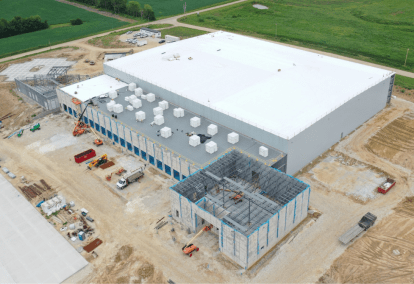
Ryan Fuesting – Director of Business Development, Brinkmann Constructors
The events of the past few years have significantly impacted the consumer experience, resulting in a positive operational shift for businesses in the cold storage market. As this specialized sector continues to grow, a trend report from Colliers anticipates cold storage real estate to experience an increase of 13.1 percent annually, boosting it to a $95 billion market by 2030.
As consumer spending habits continue to evolve, cold storage distributors remain tasked with maintaining warehousing facilities that allow for timely and efficient production, storage and distribution. Keeping these factors in mind, it’s important to take a closer look at the forces influencing the industry to understand its diverse needs.
The Rise of On-Demand Logistics
Over the past several years, the United States economy has fully embraced on-demand shopping as a primary means of acquiring goods and services. This newer niche, dubbed the on-demand logistics market, operates to fulfill customer orders as soon as they are placed. From fresh meal kits and online grocery orders to floral arrangements and pharmaceuticals, this business model has transformed the manufacturing, distribution and fulfillment needs for a wide array of companies. As another trend heavily influenced by a pandemic-centric mindset, an Allied Market Research report predicts that this segment will reach $80.6 billion by 2031. With the inevitable continuation of growth for this sector, more businesses will require temperature-regulated cold storage warehouses and distribution centers that can support timely fulfillment needs and sustain the proper climate for perishable goods.
Outdated, Unsuitable Facilities
Technology’s ongoing evolution has prompted business leaders to make mandatory shifts to remain both relevant and innovative. These shifts have resulted in the incorporation of new tools and software as well as a need for proper infrastructure. According to a report from Newmark, the average cold storage facility was built 37 years ago. Thus, many of these facilities constructed several decades ago do not support modern systems and machinery and often result in higher operational costs. With this issue at hand, companies must undergo costly capital improvement projects to bring their existing structures up to speed. As the demand for these structures continues to increase, many owners find that it is more economically feasible to start with a blank canvas and build a new facility from the ground up, equipped with the features and amenities necessary to support all operational functions.
Less Risk, More Reward
The steady influx of cold storage industrial projects has piqued the interest and attention of many developers and investors, especially those looking to make strategic investments in an uncertain economy. A recent cold storage industry report from Gitnux states that the cold storage warehousing industry in the United States is currently valued at $22 billion with a prediction to reach $100 billion within the next five years. With about 3.3 billion cubic feet of refrigerated storage space underway as of 2022, per the most recent CBRE cold storage report, this continuous demand provides investors with confidence in their transactions and anticipation for future developments.
Powerful Partnerships
When considering the next steps in an industrial cold storage project, connecting with a trusted expert is key to achieving high-quality results and long-term success. With a dedicated cold storage industrial business unit, Brinkmann Constructors brings the collective professional expertise of over 120 years, ensuring detailed planning and creative, innovative ideas from preconstruction to closeout. Equipped with this specialized knowledge, the team understands the complexities involved with constructing temperature-regulated structures, including nuances associated with installing state-of-the-art coolers, freezers, docks and more. By working as a true partner to clients, they take a second look to find the right approach to handling each project phase. After all, choosing the right partner is not just about building a facility—it's about creating a strategic asset that adds unparalleled value while meeting the ever-changing demands of the market.
With over 10 years working in commercial real estate, Ryan Fuesting has extensive experience driving meaningful growth in the cold storage industrial, senior living, multifamily and retail sectors. As a Director of Business Development, Ryan focuses on sourcing new opportunities and implementing innovative strategies to expand Brinkmann’s industrial practice. He is particularly focused on built-to-suit industrial, including cold storage, manufacturing and food and beverage.